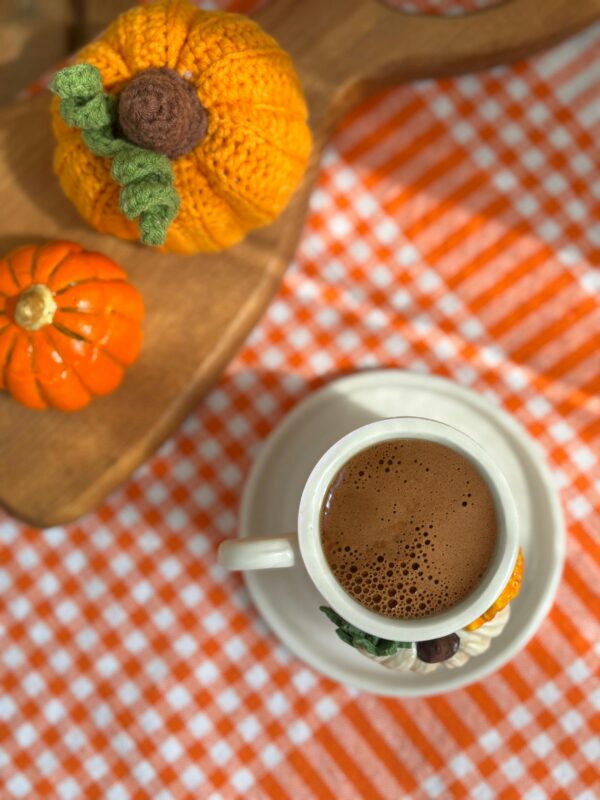If you’re new here, allow me to share the truth: I don’t sew.
PSST – I use affiliate links on my website, from Amazon as well as others – this means if you click my links, I may earn a little money at no cost to you! As an Amazon Associate I earn from qualifying purchases. I appreciate your support of my blog, and if you have questions, you can see my disclosure policy here. Thank you!
I mean, I can glue the heck out of something, but when it comes to threading bobbins or understanding what the heck a “presser foot” does, I’m out. One costuming class as a theatre major was enough to show me one creative skill I lack. Still, every once in a while, I like to dabble in beginner-friendly projects that aren’t just copy and paste of my repeat processes.
That’s why making your own tablecloth is a surprisingly doable way to dip into fabric crafts – especially for fall. It’s one of those “look how fancy I am” moments that secretly required minimal skill. You don’t need a Pinterest-perfect background in sewing. Just some fabric, a few measurements, and the willingness to iron.
So if you want to whip up some seasonal charm without crying over patterns or stretch seams, here’s how to make your own fall tablecloth with NO advanced sewing required.
This is not a do as a I say, not as a I do! I don’t even own a sewing machine!
Why DIY a Tablecloth for Fall?
Fall decor is basically begging for a crafty refresh. From Halloween to Thanksgiving, you’ve got two months of cozy, layered, pumpkin-spiced vibes that are prime for handmade accents.
You can theme your tablecloth around:
- Ghosts and bats for a Halloween dinner party
- Plaid, flannel, or leaf prints for Thanksgiving
- Just some neutral tones that feel cozy
And unlike store-bought tablecloths, yours will be the exact size, color, and aesthetic you want. Plus, it’s a great project if you want to get into simple sewing without going full Great British Sewing Bee.

What Fabric Should You Use?
The first hurdle to your project is is picking out the perfect fabric.
If you’re not a sewing expert (hi, same), go with forgiving fabrics like cotton, linen, or even canvas. These are easier to cut, sew, and lay flat on a table.
Avoid anything stretchy, slippery, or fussy. No jersey, no satin, no “but it was on sale!” regrets. You want something that stays where you put it and won’t fight you while you stitch.
And take off your jewelry! I’ve absolutely snagged fabrics with my rings, and it only adds frustration.
PSSST! Choose a fabric that coordinates with your fall decor but can last into winter too. Think dark florals, warm solids, or subtle prints.
Don’t Skip the Pre-Wash
Seriously, don’t skip this. Most fabrics will shrink a little in the wash and if you don’t pre-wash, your finished tablecloth might turn into a wonky trapezoid after one rinse cycle. Even as a non-sewer, this is a basic thing that even I know.
Toss the fabric in the wash, dry it completely, and give it a quick iron. That way, your cuts will be precise and your final product won’t betray you later.

Measure Your Table (and Add Some Wiggle Room)
Measure twice, cut once. As someone equally terrible at measurements as I am at sewing, TRUST ME. Hell, measure six times.
Lay your fabric over the table and use a soft measuring tape or a yardstick to figure out how much overhang you want. Most people like about 6–10 inches on each side.
Then add a ½ inch all around for your hem. Use fabric chalk or a washable marker to mark the cut lines. This isn’t brain surgery, just give need to give yourself enough room to cover the table and make it look polished.
Cut and Prep the Edges
This is where things get a little more real. (Did you get your six measurements in??)
Cut your fabric along your marked lines, then fold and iron a ½-inch hem all around the edges.
No cutting mat? No problem. Just lay it out on your floor or table and double-check with your tape measure. Then grab your iron and press that folded edge to create a nice crisp line.
Hemming Without Headaches
Let’s not overcomplicate this: use a basic running stitch or grab some iron-on hem tape if sewing truly isn’t your jam.
You can hand-stitch this part while watching Netflix, or use a basic sewing machine if you’re feeling brave. You just want to secure the edges so they don’t fray or look undone.
Keep your stitches small and straight, but don’t obsess over perfection. It’s homemade. That’s the charm.
Bonus: Ideas for Extra Flair
Once you’ve got the basics down, there’s lots of room to make your tablecloth stand out.
- Add heat transfer vinyl designs (pumpkins, leaves, initials)
- Use fabric paint and stencils for custom details
- Sew or glue a trim or rickrack around the edge
- Layer it over a neutral base cloth for added texture
You Did It!
Your fall DIY tablecloth is done, and it didn’t require a pattern, a meltdown, or a sewing degree. That’s a win.
Plus, you now have a handmade piece of decor that looks way more complicated than it was.


